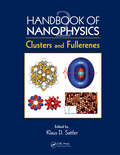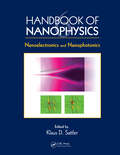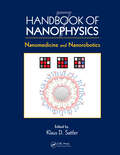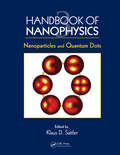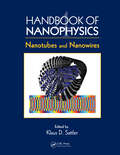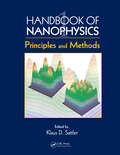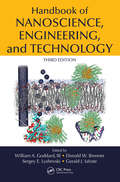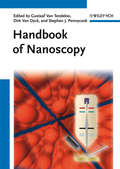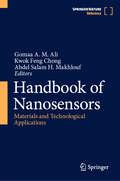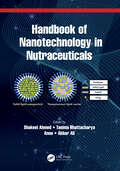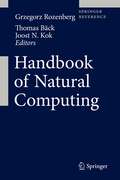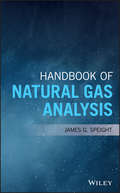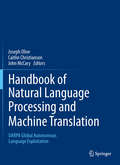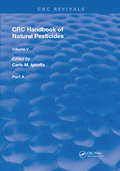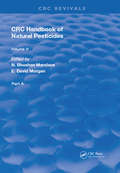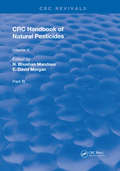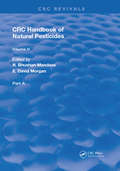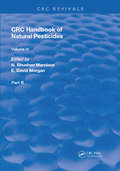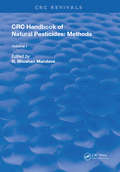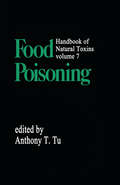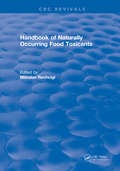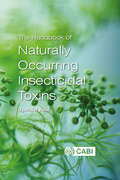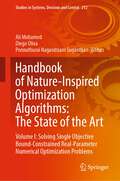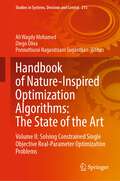- Table View
- List View
Handbook of Nanophysics: Clusters and Fullerenes (Handbook of Nanophysics)
by Klaus D. SattlerThe field of nanoscience was pioneered in the 1980s with the groundbreaking research on clusters, which later led to the discovery of fullerenes. Handbook of Nanophysics: Clusters and Fullerenes focuses on the fundamental physics of these nanoscale materials and structures. Each peer-reviewed chapter contains a broad-based introduction and enhances
Handbook of Nanophysics: Functional Nanomaterials (Handbook of Nanophysics)
by Klaus D. SattlerHandbook of Nanophysics: Functional Nanomaterials illustrates the importance of tailoring nanomaterials to achieve desired functions in applications. Each peer-reviewed chapter contains a broad-based introduction and enhances understanding of the state-of-the-art scientific content through fundamental equations and illustrations, some in color.This
Handbook of Nanophysics: Nanoelectronics and Nanophotonics (Handbook of Nanophysics)
by Klaus D. SattlerMany bottom-up and top-down techniques for nanomaterial and nanostructure generation have enabled the development of applications in nanoelectronics and nanophotonics. Handbook of Nanophysics: Nanoelectronics and Nanophotonics explores important recent applications of nanophysics in the areas of electronics and photonics. Each peer-reviewed c
Handbook of Nanophysics: Nanomedicine and Nanorobotics
by Klaus D. SattlerThe tools of nanodiagnostics, nanotherapy, and nanorobotics are expected to revolutionize the future of medicine, leading to presymptomatic diagnosis of disease, highly effective targeted treatment therapy, and minimum side effects. Handbook of Nanophysics: Nanomedicine and Nanorobotics presents an up-to-date overview of the application of nan
Handbook of Nanophysics: Nanoparticles and Quantum Dots (Handbook of Nanophysics)
by Klaus D. SattlerIn the 1990s, nanoparticles and quantum dots began to be used in optical, electronic, and biological applications. Now they are being studied for use in solid-state quantum computation, tumor imaging, and photovoltaics. Handbook of Nanophysics: Nanoparticles and Quantum Dots focuses on the fundamental physics of these nanoscale materials and struct
Handbook of Nanophysics: Nanotubes and Nanowires
by Klaus D. SattlerIntensive research on fullerenes, nanoparticles, and quantum dots in the 1990s led to interest in nanotubes and nanowires in subsequent years. Handbook of Nanophysics: Nanotubes and Nanowires focuses on the fundamental physics and latest applications of these important nanoscale materials and structures. Each peer-reviewed chapter contains a broad-
Handbook of Nanophysics: Principles and Methods (Handbook of Nanophysics)
by Klaus D. SattlerCovering the key theories, tools, and techniques of this dynamic field, Handbook of Nanophysics: Principles and Methods elucidates the general theoretical principles and measurements of nanoscale systems. Each peer-reviewed chapter contains a broad-based introduction and enhances understanding of the state-of-the-art scientific content through fund
Handbook of Nanoscience, Engineering, and Technology (Electrical Engineering Handbook)
by William A. Goddard, Donald W. Brenner, Sergey E. Lyshevski and Gerald J. IafrateIn his 1959 address, "There is Plenty of Room at the Bottom," Richard P. Feynman speculated about manipulating materials atom by atom and challenged the technical community "to find ways of manipulating and controlling things on a small scale." This visionary challenge has now become a reality, with recent advances enabling atomistic-level tailoring and control of materials. Exemplifying Feynman’s vision, Handbook of Nanoscience, Engineering, and Technology, Third Edition continues to explore innovative nanoscience, engineering, and technology areas. Along with updating all chapters, this third edition extends the coverage of emerging nano areas even further. Two entirely new sections on energy and biology cover nanomaterials for energy storage devices, photovoltaics, DNA devices and assembly, digital microfluidic lab-on-a-chip, and much more. This edition also includes new chapters on nanomagnet logic, quantum transport at the nanoscale, terahertz emission from Bloch oscillator systems, molecular logic, electronic optics in graphene, and electromagnetic metamaterials. With contributions from top scientists and researchers from around the globe, this color handbook presents a unified, up-to-date account of the most promising technologies and developments in the nano field. It sets the stage for the next revolution of nanoscale manufacturing—where scalable technologies are used to manufacture large numbers of devices with complex functionalities.
Handbook of Nanoscopy, 2 Volume Set
by Stephen J. Pennycook Dirk Van Dyck Gustaaf Van TendelooThis completely revised successor to the Handbook of Microscopy supplies in-depth coverage of all imaging technologies from the optical to the electron and scanning techniques. Adopting a twofold approach, the book firstly presents the various technologies as such, before going on to cover the materials class by class, analyzing how the different imaging methods can be successfully applied. It covers the latest developments in techniques, such as in-situ TEM, 3D imaging in TEM and SEM, as well as a broad range of material types, including metals, alloys, ceramics, polymers, semiconductors, minerals, quasicrystals, amorphous solids, among others. The volumes are divided between methods and applications, making this both a reliable reference and handbook for chemists, physicists, biologists, materials scientists and engineers, as well as graduate students and their lecturers.
Handbook of Nanosensors: Materials and Technological Applications
by Gomaa A. M. Ali Abdel Salam H. Makhlouf Kwok Feng ChongThis book discusses the advances in sensor technologies and sensing efficiency. It highlights different sensor applications, including humidity, gas, fluorescent, biological, optical, radiation, etc. The chapters discuss recycled and biodegradable materials-based sensors as well as sensing techniques and theories. The different approaches employed to modify the electrode surfaces of sensors to lower the overpotential, enhance sensitivity to enrich the desired species and/or lessen the influence of interferences are also covered. This handbook is structured in seven sections including fundamentals of sensor technologies, types of sensors, and medical, biological, environmental, and industrial applications of sensors.
Handbook of Nanotechnology in Nutraceuticals
by Shakeel Ahmed Tanima Bhattacharya Annu Akbar AliNanotechnology has been emerging as an important tool in the nutraceutical and food industries to improve the overall quality of life. Nanotechnology has established a new horizon by bestowing modified properties on nanomaterials and applying them to the production of nanoformulations, nutritional supplements, and the food industry. The Handbook of Nanotechnology in Nutraceuticals highlights the impact of nanotechnology on the food industries. The book focuses on the application of nanotechnology in nutraceuticals and the food industry to improve the overall quality of life. The book also addresses some important applications of nano-nutraceuticals in the treatment of different diseases, such as oxidative stress, cancer, neurodegenerative disorders, cardiovascular diseases, and so on. Features • Presents a scientometric approach to analyze the emergence of nano-nutraceuticals in cancer prevention and treatment • Examines various strategies employed to prepare nanocarrier systems, such as nanoparticles, nanostructure lipids, phospholipid-based nanocarriers, polysaccharide-based nanostructures, and metal nanoparticles • Discusses various regulatory issues related to nanotechnology and their application in different fields This book is a valuable reference for nanotechnologists, scientists, and researchers working in the field of food technology, food science, pharmaceuticals, and nutraceuticals.
Handbook of Natural Computing
by Thomas Bäck Grzegorz Rozenberg Joost N. KokNatural Computing is the field of research that investigates both human-designed computing inspired by nature and computing taking place in nature, i.e., it investigates models and computational techniques inspired by nature and also it investigates phenomena taking place in nature in terms of information processing. Examples of the first strand of research covered by the handbook include neural computation inspired by the functioning of the brain; evolutionary computation inspired by Darwinian evolution of species; cellular automata inspired by intercellular communication; swarm intelligence inspired by the behavior of groups of organisms; artificial immune systems inspired by the natural immune system; artificial life systems inspired by the properties of natural life in general; membrane computing inspired by the compartmentalized ways in which cells process information; and amorphous computing inspired by morphogenesis. Other examples of natural-computing paradigms are molecular computing and quantum computing, where the goal is to replace traditional electronic hardware, e.g., by bioware in molecular computing. In molecular computing, data are encoded as biomolecules and then molecular biology tools are used to transform the data, thus performing computations. In quantum computing, one exploits quantum-mechanical phenomena to perform computations and secure communications more efficiently than classical physics and, hence, traditional hardware allows. The second strand of research covered by the handbook, computation taking place in nature, is represented by investigations into, among others, the computational nature of self-assembly, which lies at the core of nanoscience, the computational nature of developmental processes, the computational nature of biochemical reactions, the computational nature of bacterial communication, the computational nature of brain processes, and the systems biology approach to bionetworks where cellular processes are treated in terms of communication and interaction, and, hence, in terms of computation. We are now witnessing exciting interaction between computer science and the natural sciences. While the natural sciences are rapidly absorbing notions, techniques and methodologies intrinsic to information processing, computer science is adapting and extending its traditional notion of computation, and computational techniques, to account for computation taking place in nature around us. Natural Computing is an important catalyst for this two-way interaction, and this handbook is a major record of this important development.
Handbook of Natural Gas Analysis
by James G. SpeightA comprehensive resource to the origin, properties, and analysis of natural gas and its constituents Handbook of Natural Gas Analysis is a comprehensive guide that includes information on the origin and analysis of natural gas, the standard test methods, and procedures that help with the predictability of gas composition and behavior during gas cleaning operations and use. The author—a noted expert on the topic—also explores the properties and behavior of the various components of natural gas and gas condensate. All chapters are written as stand-alone chapters and they cover a wealth of topics including history and uses; origin and production; composition and properties; recovery, storage, and transportation; properties and analysis of gas stream and gas condensate. The text is designed to help with the identification of quality criteria appropriate analysis and testing that fall under the umbrella of ASTM International. ASTM is an organization that is recognized globally across borders, disciplines and industries and works to improve performance in manufacturing and materials and products. This important guide: Contains detailed information on natural gas and its constituents Offers an analysis of methane, gas hydrates, ethane, propane, butane, and gas condensate Includes information on the behavior of natural gas to aid in the planning for recovery, storage, transportation, and use Covers the test methods that are applicable to natural gas and its constituents Written in accessible and easy-to-understand terms Written for scientists, engineers, analytical chemists who work with natural gas as well as other scientists and engineers in the industry, Handbook of Natural Gas Analysis offers a guide to the analysis, standard test methods, and procedures that aid in the predictability of gas composition and behavior during gas cleaning operations and use.
Handbook of Natural Language Processing and Machine Translation: DARPA Global Autonomous Language Exploitation
by Caitlin Christianson Joseph Olive John MccaryThis comprehensive handbook, written by leading experts in the field, details the groundbreaking research conducted under the breakthrough GALE program--The Global Autonomous Language Exploitation within the Defense Advanced Research Projects Agency (DARPA), while placing it in the context of previous research in the fields of natural language and signal processing, artificial intelligence and machine translation. The most fundamental contrast between GALE and its predecessor programs was its holistic integration of previously separate or sequential processes. In earlier language research programs, each of the individual processes was performed separately and sequentially: speech recognition, language recognition, transcription, translation, and content summarization. The GALE program employed a distinctly new approach by executing these processes simultaneously. Speech and language recognition algorithms now aid translation and transcription processes and vice versa. This combination of previously distinct processes has produced significant research and performance breakthroughs and has fundamentally changed the natural language processing and machine translation fields. This comprehensive handbook provides an exhaustive exploration into these latest technologies in natural language, speech and signal processing, and machine translation, providing researchers, practitioners and students with an authoritative reference on the topic.
Handbook of Natural Pesticides: Microorganisms, Part A, Volume V
by N. Bhushan MandavaThis handbook series includes several naturally occurring chemicals that exhibit biological activity. These chemicals are derived from plants, insects, and several microorganisms. Volume I of this series is covers the theory and practice of the strategies for pest control and methods for detection.Moreover, it presents extensive tables that provide the information you need to select the most appropriate bioassay for a particular plant growth regulator or hormone. In addition to the chapters on bioassays, Volume I provides a solid introduction to the theory and practice of natural pesticide use, including in-depth discussions of integrated management systems for weed and pest control, the state-of-the-art use of computers in pest management, and allelochemicals as natural protection. Guidelines on toxicological testing and EPA regulation of natural pesticides are also detailed.
Handbook of Natural Pesticides: Part A, Volume III
by N. Bhushan MandavaThis handbook series includes several naturally occurring chemicals that exhibit biological activity. These chemicals are derived from plants, insects, and several microorganisms. Volume I of this series is covers the theory and practice of the strategies for pest control and methods for detection.Moreover, it presents extensive tables that provide the information you need to select the most appropriate bioassay for a particular plant growth regulator or hormone. In addition to the chapters on bioassays, Volume I provides a solid introduction to the theory and practice of natural pesticide use, including in-depth discussions of integrated management systems for weed and pest control, the state-of-the-art use of computers in pest management, and allelochemicals as natural protection. Guidelines on toxicological testing and EPA regulation of natural pesticides are also detailed.
Handbook of Natural Pesticides: Part B, Volume III
by N. Bhushan MandavaThis handbook series includes several naturally occurring chemicals that exhibit biological activity. These chemicals are derived from plants, insects, and several microorganisms. Volume I of this series is covers the theory and practice of the strategies for pest control and methods for detection.Moreover, it presents extensive tables that provide the information you need to select the most appropriate bioassay for a particular plant growth regulator or hormone. In addition to the chapters on bioassays, Volume I provides a solid introduction to the theory and practice of natural pesticide use, including in-depth discussions of integrated management systems for weed and pest control, the state-of-the-art use of computers in pest management, and allelochemicals as natural protection. Guidelines on toxicological testing and EPA regulation of natural pesticides are also detailed.
Handbook of Natural Pesticides: Pheromono, Part A, Volume IV
by N. Bhushan MandavaThis handbook series includes several naturally occurring chemicals that exhibit biological activity. These chemicals are derived from plants, insects, and several microorganisms. Volume I of this series is covers the theory and practice of the strategies for pest control and methods for detection.Moreover, it presents extensive tables that provide the information you need to select the most appropriate bioassay for a particular plant growth regulator or hormone. In addition to the chapters on bioassays, Volume I provides a solid introduction to the theory and practice of natural pesticide use, including in-depth discussions of integrated management systems for weed and pest control, the state-of-the-art use of computers in pest management, and allelochemicals as natural protection. Guidelines on toxicological testing and EPA regulation of natural pesticides are also detailed.
Handbook of Natural Pesticides: Pheromono, Part B, Volume IV
by N. Bhushan MandavaThis handbook series includes several naturally occurring chemicals that exhibit biological activity. These chemicals are derived from plants, insects, and several microorganisms. Volume I of this series is covers the theory and practice of the strategies for pest control and methods for detection.Moreover, it presents extensive tables that provide the information you need to select the most appropriate bioassay for a particular plant growth regulator or hormone. In addition to the chapters on bioassays, Volume I provides a solid introduction to the theory and practice of natural pesticide use, including in-depth discussions of integrated management systems for weed and pest control, the state-of-the-art use of computers in pest management, and allelochemicals as natural protection. Guidelines on toxicological testing and EPA regulation of natural pesticides are also detailed.
Handbook of Natural Pesticides: Volume I: Theory, Practice, and Detection (Crc Series In Naturally Occurring Pesticides)
by N. Bhushan MandavaThis handbook series includes several naturally occurring chemicals that exhibit biological activity. These chemicals are derived from plants, insects, and several microorganisms. Volume I of this series is covers the theory and practice of the strategies for pest control and methods for detection.Moreover, it presents extensive tables that provide the information you need to select the most appropriate bioassay for a particular plant growth regulator or hormone. In addition to the chapters on bioassays, Volume I provides a solid introduction to the theory and practice of natural pesticide use, including in-depth discussions of integrated management systems for weed and pest control, the state-of-the-art use of computers in pest management, and allelochemicals as natural protection. Guidelines on toxicological testing and EPA regulation of natural pesticides are also detailed.
Handbook of Natural Toxins: Food Poisoning
by Anthony T. TuThis resource discusses all aspects of food poisoning and its sources such as bacteria, plant, and fungus - presenting the pathogens and food toxins in detail. Featuring contributions from over 30 leading authorities in the field, Food Poisoning ...: describes bacterial food contaminants including staphylococcal, salmonellae, E. coli, Clostridium perfringens, Bacillus cereus, cholera, and botulism; covers the prevention and treatment of mushroom and other poisonings from grains and plant-type foods; explains how to aid allergic reactions resulting from eating certain foods; identifies which kinds of seafood may cause severe poisoning; explores teratogenic aspects of food poisoning, outlining which foods pregnant women should avoid; and shows how those sensitive to nitrosamines can avoid such food poisoning.;Extensively referenced with more than 2200 literature citations, Volume 7: Food Poisoning serves as essential reading for toxicologists, microbiologists, dietitians and nutritionists, public health officials, food scientists and technologists, agricultural chemists and biochemists, bacteriologists, and graduate-level students in food science and toxicology.
Handbook of Naturally Occurring Food Toxicants (Crc Series In Nutrition And Food)
by Miloslav RechciglIn the last decade an increased concern has been voiced against various environmental hazards, particularly chemicals that may cause harm to humans or animals. Numerous studies which have dealt with this subject invariably have focused on chemical contaminants of some component of a food chain. In contrast, much less attention has been paid to the potentially harmful substances that may occur in foodstuffs naturally. The purpose of this Handbook is to sensitize the reader to this problem and to provide a systematic overview of the most important naturally occurring food toxicants. The Handbook should be of interest to anybody who is concerned with nutritive and health aspects of food. Inasmuch as many of the discussed toxicants can be removed or destroyed by a suitable method of food rpocessing it should be of special value to food technologists.
Handbook of Naturally Occurring Insecticidal Toxins, The
by Opender KoulNaturally occurring toxins are among the most complicated and lethal in existence. Plant species, microorganisms and marine flora and fauna produce hundreds of toxic compounds for defence and to promote their chances of survival, and these can be isolated and appropriated for our own use. Many of these toxins have yet to be thoroughly described, despite being studied for years. Focusing on the natural toxins that are purely toxic to insects, this book contains over 500 chemical structures. It discusses the concepts and mechanisms involved in toxicity, bioassay procedures for evaluation, structure-activity relationships, and the potential for future commercialization of these compounds. A comprehensive review of the subject, this book forms an important source of information for researchers and students of crop protection, pest control, phytochemistry and those dealing in insect-plant interactions.
Handbook of Nature-Inspired Optimization Algorithms: Volume I: Solving Single Objective Bound-Constrained Real-Parameter Numerical Optimization Problems (Studies in Systems, Decision and Control #212)
by Ponnuthurai Nagaratnam Suganthan Diego Oliva Ali MohamedThe introduction of nature-inspired optimization algorithms (NIOAs), over the past three decades, helped solve nonlinear, high-dimensional, and complex computational optimization problems. NIOAs have been originally developed to overcome the challenges of global optimization problems such as nonlinearity, non-convexity, non-continuity, non-differentiability, and/or multimodality which traditional numerical optimization techniques had difficulties solving. The main objective for this book is to make available a self-contained collection of modern research addressing the general bound-constrained optimization problems in many real-world applications using nature-inspired optimization algorithms. This book is suitable for a graduate class on optimization, but will also be useful for interested senior students working on their research projects.
Handbook of Nature-Inspired Optimization Algorithms: Volume II: Solving Constrained Single Objective Real-Parameter Optimization Problems (Studies in Systems, Decision and Control #213)
by Ponnuthurai Nagaratnam Suganthan Diego Oliva Ali Wagdy MohamedThis book presents recent contributions and significant development, advanced issues, and challenges. In real-world problems and applications, most of the optimization problems involve different types of constraints. These problems are called constrained optimization problems (COPs). The optimization of the constrained optimization problems is considered a challenging task since the optimum solution(s) must be feasible. In their original design, evolutionary algorithms (EAs) are able to solve unconstrained optimization problems effectively. As a result, in the past decade, many researchers have developed a variety of constraint handling techniques, incorporated into (EAs) designs, to counter this deficiency.The main objective for this book is to make available a self-contained collection of modern research addressing the general constrained optimization problems in many real-world applications using nature-inspired optimization algorithms. This book is suitable for a graduate class on optimization, but will also be useful for interested senior students working on their research projects.
